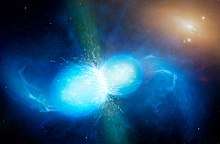2017 SX17
2017 SX17 is a very small asteroid, classified as a near-Earth object of the Apollo group, approximately 6–12 meters (20–40 feet) in diameter. It was first observed by astronomers of the Mount Lemmon Survey at Mount Lemmon Observatory on 29 September 2017, three days prior to its sub-lunar close encounter with Earth at 0.23 lunar distances on 2 October 2017.[1][2]
| Discovery [1] | |
|---|---|
| Discovered by | Mount Lemmon Srvy. |
| Discovery site | Mount Lemon Obs. |
| Discovery date | 29 September 2017 |
| Designations | |
| 2017 SX17 | |
| NEO · Apollo [1][2] | |
| Orbital characteristics [2] | |
| Epoch 23 March 2018 (JD 2458200.5) | |
| Uncertainty parameter 5 | |
| Observation arc | 8 days |
| Aphelion | 1.4625 AU |
| Perihelion | 0.8673 AU |
| 1.1649 AU | |
| Eccentricity | 0.2555 |
| 1.26 yr (459 d) | |
| 90.265° | |
| 0° 47m 2.4s / day | |
| Inclination | 2.8675° |
| 189.81° | |
| 249.11° | |
| Earth MOID | 0.00082 AU (0.32 LD) |
| Physical characteristics | |
Mean diameter | 6 m (est. at 0.24)[3] 8 m (estimate)[4] 12 m (est. at 0.057)[3] |
| 28.3[2] | |
Orbit and classification
2017 SX17 is a member of the Apollo asteroids, which cross the orbit of Earth. Apollo's are the largest group of near-Earth objects with approximately 10 thousand known objects.
It orbits the Sun at a distance of 0.87–1.46 AU once every 15 months (459 days; semi-major axis of 1.16 AU). Its orbit has an eccentricity of 0.26 and an inclination of 3° with respect to the ecliptic.[2]
The body's observation arc begins with an observation made by Pan-STARRS on 24 September 2017, five days prior to its official first observation.[1]
Close approaches
The object last approached the Earth on 2 October 2017, at 10:20 UT, at a distance of 87,065 kilometres (54,100 miles) at a speed of 26,310 km/h (16,350 mph).[4] This distance corresponds to 0.000582 AU (0.226 LD).[2]
After the 2017-flyby, it still has an exceptionally low minimum orbital intersection distance with Earth of 123,000 km (0.00082 AU), or 0.032 lunar distances (LD).[2]
Physical characteristics
Based on a generic magnitude-to-diameter conversion, 2017 SX17 measures between 6–12 meters (20–40 feet) in diameter, for an absolute magnitude of 28.3, and an assumed albedo between 0.057 and 0.24, which represent typical values for carbonaceous and stony asteroids, respectively.[3]
As of 2018, no rotational lightcurve has been obtained from photometric observations. The body's rotation period, pole and shape remain unknown.[2]
Numbering and naming
This minor planet has neither been numbered nor named by the Minor Planet Center.[1]
References
- "2017 SX17". Minor Planet Center. Retrieved 21 March 2018.
- "JPL Small-Body Database Browser: (2017 SX17)" (2017-10-02 last obs.). Jet Propulsion Laboratory. Retrieved 21 March 2018.
- "Asteroid Size Estimator". CNEOS NASA/JPL. Retrieved 21 March 2018.
- Steve Spaleta (2 October 2017). "Bus-Size Asteroid Zooms by Earth in Close (But Harmless) Encounter". Retrieved 2 October 2017.
External links
- Bus-sized asteroid 2017 SX17 gives Earth a close shave, Skymania
- Asteroid 2017 SX17 to flyby Earth at 0.23 LD on October 2, The Watchers
- Bus-Size Asteroid Zooms by Earth in Close (But Harmless) Encounter, Space.com
- Asteroid 2017 SX17 close approach, International Asteroid Warning Network (IAWN)
- List Of Apollo Minor Planets (by designation), Minor Planet Center
- 2017 SX17 at NeoDyS-2, Near Earth Objects—Dynamic Site
- Ephemeris · Obs prediction · Orbital info · MOID · Proper elements · Obs info · Close · Physical info · NEOCC
- 2017 SX17 at the JPL Small-Body Database



